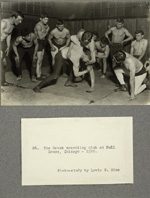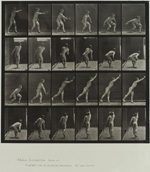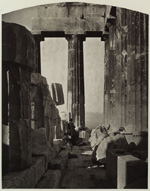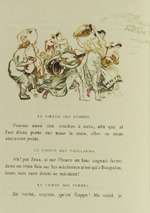Section Three
 17 OLYMPIC GAMES
17 OLYMPIC GAMES
Lewis Wickes Hine (American, 1874–1940)
The Greek Wrestling Club at Hull House, Chicago
1910. Gelatin silver print
Miriam and Ira D. Wallach Division
of Art, Prints and Photographs, Photography Collection
Founded in Chicago in 1889 by social reformer Jane Addams,
Hull House was among the first settlement houses in the United
States dedicated to serving the needs of immigrants and their
families. In addition to providing educational functions from
kindergarten to college-level extension classes, Hull House
included craft workshops, playgrounds, and, as seen in this
photograph by Lewis Wickes Hine, a gymnasium as the home for
its Greek Wrestling Club.
Wrestling was one of the main competitive sports in the original
Olympic Games, as well as in the revived Olympiad of 1896.
In contrast to the modern-day ideal notion that the winner
of a match should be decided by a demonstration of superior,
play-by-the-rules skill and strength, in some forms of wrestling
in the ancient games the victorious contestant often ended
up with the olive wreath by exercising a vicious, bloody, no-holds-barred
attack upon his opponent.
 18 OLYMPIC
GAMES
18 OLYMPIC
GAMES
"Discus Thrower," plate 307 from:
Eadweard Muybridge
(English, 1830–1904)
Animal Locomotion. An Electro-Photographic
Investigation of Consecutive Phases of Animal Movements. 1872–1885
Philadelphia: University of Pennsylvania, 1887
11 volumes
with 781 photographic plates
Plates printed by the
Photogravure company, Philadelphia
Miriam and Ira D. Wallach
Division of Art, Prints and Photographs, Photography Collection
The discus throw, mentioned by Homer in both the Iliad and
the Odyssey, was one of five events (also including
the footrace, long jump, javelin throw, and wrestling match)
taking place on the same day in the pentathlon in the ancient
Olympic Games. The discus throw was reintroduced in the modern-era
revival of the Olympics as a Track and Field event. The bronze
sculpture of the Diskobolos, caught in fleeting action
by the fifth-century sculptor Myron, remains one of the most
ubiquitous images in all of Greek art.
Eadweard Muybridge, who immigrated to the United States around
1852, worked as a bookseller early in his career. After studying
photography, Muybridge, describing himself as an artist-photographer
and adopting “Helios” as his artist’s name, made a reputation
with his spectacular views of Yosemite and other scenic western
sites. Later, he made many systematic analyses of moving figures
(humans and animals) by taking sequences of photographs with
banks of cameras fitted with high-speed shutters.
While encouraging the aura of scientific investigation to
surround his work, Muybridge also sought to convey the serious
overtones of history by adapting the movements of athletic
competitions from the ancient Olympic Games as references for
his contemporary stop-action experiments, as may be seen here
in the twenty-four shots of an athlete photographed in the
act of throwing a discus.
 19 THE
ACROPOLIS
19 THE
ACROPOLIS
William James Stillman (American, 1828–1901)
The Acropolis of Athens, illustrated picturesquely and
architecturally in photography
London: F. S. Ellis, 1870
Album of 25 mounted photographic
plates, with descriptive letterpress text
Miriam and Ira D.
Wallach Division of Art, Prints and Photographs, Photography
Collection
The Parthenon, the temple dedicated to the virgin warrior
goddess Athena Parthenos situated atop the Acropolis in Athens,
is the most renowned building to survive from the ancient world.
By the fifth century B.C.E., the Acropolis had evolved over
the centuries from a citadel fortress to the site of sanctuaries
and memorials, the locus of enlightened civic government, and
the experimental birthplace of democracy. Pericles (ca. 495–429
B.C.E.), the virtuous Athenian statesman largely credited with
instituting a form of popular vote and with forging the cultural
and political supremacy of Athens over other city-states, instigated
construction of the Parthenon in 447 B.C.E. The Parthenon and
its setting included Pheidias’s gold and ivory cult statue
of Athena, a temple devoted to Victory, the Erectheum, and
the Propylaea, the monumental gateway leading to the sacred
precinct. It is impossible to overestimate the architectural
legacy of the Parthenon throughout the Western world – its
innovative plan, harmonious use of the Doric order, the lavishness
of its mouldings, and the awesome scale of its sculptural program.
Following early careers as a painter associated with the Hudson
River School and as founding editor of the art journal the Crayon,
William James Stillman took up photography in 1859. Continuing
as a journalist and travel writer abroad, Stillman put his
skills as a photographer to use while serving as consul in
Rome and Crete. His major achievement in the art of photography
was the series of twenty-five technically and formally beautiful
photographs that appeared in The Acropolis of Athens.
Ten are shown here, identified by Stillman’s corresponding
captions.
a. The Acropolis, with the theatre of Bacchus.
View taken from the proscenium of the theatre. The architrave
of the Parthenon is seen above the fortification wall.
b. Western façade of the Parthenon. At the right is Hymettus,
at the left the summit of Lycabetus is seen, and at the
extreme left is the Erectheum. The débris in the foreground
are architectural and sculptural fragments.
c. The eastern façade of the Propylaea. The island
and bay of Salamis are seen through the central intercolumniations,
and through those at the left of the port of Peiraeus.
d. Interior of the Parthenon, taken from the western gate.
The circular grooves are those in which the bronze valves
swing.
e. Western portion of the Parthenon. The names scratched
on the columns are of the Philhellenes, who fought here in
the war of Greek independence.
f. Eastern portico of the Parthenon, view looking northward,
and showing Mount Parnes in the extreme distance.
g. Eastern façade, or front, of the Parthenon.
h. Interior of the Parthenon, from the eastern end; at
the left, in the distance, is seen the island of Aegina.
i. View … looking eastward over the ruin of the
Parthenon. Modern Athens is seen at the left, and above it,
in the centre, Lycabetus; at the right Hymettus, and in the
extreme distance, Pentelicus.
j. View of the Acropolis, from the Musaem Hill.
A portion of modern Athens, is visible at the left; at the
right is seen the course of the Ilissus, and the remaining
columns of the Temple of Jupiter, beyond which rises Mount
Hymettus. The view is eastward.
20 GIORGIO DE CHIRICO
Giorgio de Chirico (Italian, born in Greece, 1888–1978)
The Return of the Prodigal Son I, from a series of
six lithographs, Metamorphosis
1929. Lithograph printed in three colors
Published by Editions
des Quatre Cjemins, Paris
Miriam and Ira D. Wallach Division
of Art, Prints and Photographs, Print Collection, Norrie Fund
Giorgio de Chirico, most often identified as the founder of pittura
metafisica and crucial to the early development of surrealist
painting, was born in Vólos, Greece, the port city from which
Jason and the Argonauts were said to have departed in their
quest to regain the Golden Fleece. Both de Chirico and his
younger brother Andrea (the painter and composer who later
adopted the name Alberto Savinio) received their artistic
training with some of the most prominent Greek painters and
musicians of the time in Athens, where de Chirico continued
to live until his father’s death in 1905. Greek art and culture
remained deeply rooted in de Chirico’s art throughout his
long, contentious, and richly varied career.
The Return of the Prodigal Son I (mistakenly called Socrates when
acquired by the Library in 1946) is one of numerous works,
including several related paintings entitled the Archaeologists,
in which de Chirico creatively adapted elements from classical
Greek architecture to construct his figures. In this lithograph,
as the ghost-like wayward son stands by, the father sits rigidly
in his armchair, his torso, upper arms, thighs, and top hat
composed of Ionic columns, voluted capitals, and temple pediments.
Knowing that ancient Greek architecture did not consist of
a collection of purely white marble temples, de Chirico indicated
traces of paint on the figure of the father that once would
have blazed with colors.
21 SIR WILLIAM HAMILTON
Pierre-François Hugues d'Hancarville (French, 1719–1805)
Antiquités étrusques, grecques et romaines … gravées
par F. A. David
Paris: Chez l'auteur, 1785–87
Four volumes in 24 parts,
with 289 etching and aquatint plates
The George Arents Collection
of Books in Parts
Sir William Hamilton (1730–1803) served George III as British
ambassador to the Kingdom of Naples for over thirty years,
a period when archaeological excavations, antiquities trading,
and the pillaging of tombs were rife in southern Italy and
throughout the Hellenic world. From the time of his arrival
in Naples, Hamilton began amassing a vast collection of classical
art and artifacts. In 1772, he sold to the British Museum 730
Greek vases and 175 terracottas, as well as glass, bronzes,
gems, and thousands of coins, forming part of one of the richest
collections of ancient art in the world today.
In 1766, Hamilton commissioned Baron d’Hancarville, an antiquary
(and evidently a small-time criminal), to catalogue and publish
his collection of vases, which appeared in four sumptuously
illustrated, oversized volumes. New editions followed, including
this French edition of 1785–87 in greatly reduced format (four
of twenty-four separately issued parts are shown). Open here,
vol. 1, plate 9, depicts preparations for the marriage of Helen
and Paris on a vase found at Capua; vol. 3, plate 25, according
to d’Hancarville, is a scene from the Feast of Dionysus.
The plates in Hamilton’s catalogues, representing only a small
part of the collection, reproduced a wide range of subjects,
including legendary Greek heroes, gods and goddesses, athletes,
and architectural elements. The subjects of the vases, their
frieze-like compositions, and the crisp linearity in which
they were drawn exerted enormous influence on the emerging
neoclassical style in ceramics, interiors, architecture, decorative
motifs, and major works by Flaxman, David, Fuseli, Ingres,
Girodet, Joshua Wedgwood, and countless other artists.
22 SOPHOCLES
Sophocles (ca. 496–406 B.C.E.) and Eduard Bargheer (German,
1901–1979)
Antigone. In der Übersetzung von Karl Reinhardt
Frankfurt am Main: Verlag Ars librorum, Gotthard de Beauclair,
1967
Artist’s book with 10 etchings and one etching and aquatint
on front cover by Eduard Bargheer; printed by Arnd Maibau,
Berlin. No. 40 of 200 copies
Spencer Collection
Sophocles’ tragedy Antigone (written in 442 B.C.E.)
was performed by three rather than the traditional two actors,
which represented the playwright’s major dramatic innovation.
Prior to the beginning of the play, Antigone, daughter of Oedipus,
former king of Thebes, has lived in exile for many years with
her blind father. In the play, King Creon, Antigone’s uncle,
decrees that the corpse of the slain traitor Polyneices, her
brother, must not be buried. Antigone defies the order and
is sentenced to death. Although betrothed to Creon’s son Haemon,
she is buried alive in a cave. After the blind prophet Tiresias
reveals that the gods have sided with Antigone against him,
Creon relents, but only after Antigone has already hanged herself.
Haemon attacks his father and kills himself. Creon's wife,
Eurydice, then commits suicide, leaving Creon alone with his
niece, Antigone’s sister. The frequent subject of contemporary
reinterpretations, Antigone was recently described in
a New York Times review of a five-part, fragmented production
as “a Theban tear-jerker,” and the “ultimate story of a dysfunctional
family.”
On the front cover of his illustrated edition, German painter
and printmaker Eduard Bargheer has portrayed Antigone with
the stony face, staring eyes, enigmatic expression, and hairstyle
of an Archaic period korê, the female sculptural counterpart
of Picasso’s kouros in Pindare.
VIIIe Pythique, exhibited (#16) on the other side of
the gallery.
 23 ARISTOPHANES
23 ARISTOPHANES
Aristophanes (448?–385? B.C.E.) and Frantisek Kupka (Bohemian,
1871–1957)
Lysistrate … traduit du grèc par Lucien Dhuys; gravures
originales de François Kupka
Paris: A. Blaizot, 1911
Illustrated with a full-page frontispiece
and 19 headpieces in etching and aquatint printed in colors à la poupée;
extra double suites of the etchings and 12 wood engravings.
No. 42 of 100 copies on Japon impérial paper from a total
edition of 250 copies
Spencer Collection
Lysistrata (411 B.C.E.), a troubling mix of gravity
and farce, is one of the greatest and still most frequently
performed comedies from antiquity. In his play, Aristophanes
openly mocked the political leaders and citizens of Athens
who supported a twenty-year war against Sparta. The playwright
imagines a strike by the women of Athens, instigated by Lysistrata,
who seize the Acropolis and the city’s treasury, and then reject
all sexual advances by their husbands as long as the war continues
to be waged. The men of Athens, in agony over their sex-starved
condition, are forced to capitulate and to negotiate the peace.
Kupka visualizes the plot of the play by presenting a frieze-like
procession of animated characters across the upper margins
of fifteen pages, including here, in a double-spread lineup,
a cross section of distressed Athenian men. For too long viewed
merely as a pioneer of abstract painting, Kupka, early in his
career, was also an extremely witty and incisive illustrator
of texts, as Lysistrate vividly demonstrates.
24 AESCHYLUS
Charles-Marie-René Leconte de Lisle (French, 1818–1894)
and Frantisek Kupka (Bohemian, 1871–1957)
Les
Erinnyés: tragédie antique … illustrée des compositions
et gravures à l’eau forte de François Kupka
Paris: A. Romagnol,
1908
Two-part play, illustrated with 75 etching and aquatints,
and head- and tailpieces, with additional plate proofs in pure
etching and before the letters, and 22 wood engravings. No.
1 of 10 large paper copies on Vélin d’Arches paper from a total
edition of 300 copies; and with one full-page watercolor and
18 watercolor vignettes
Spencer Collection
The leader of the nineteenth-century Parnassians, French poets
recognized for the classical restraint and technical perfection
of their works, Leconte de Lisle translated and adapted Aeschylus’s
trilogy the Oresteia for a contemporary audience. In
Leconte de Lisle’s two-part adaptation Les Erinnyés,
the furies (les erinnyés), minor goddesses who specialize
in enacting revenge upon the evildoers of the world, torment
Orestes for murdering his mother, Clytemnestra, who had killed
his father, Agamemnon.
In copy 1 of Les Erinnyés, shown here, Kupka embellished
the lower margins with a series of colorful watercolor vignettes
of the principal and supporting characters, in addition to
sea monsters, rollicking mermaids, tumescent satyrs, seductive
sirens, and raping centaurs. On an elaborately decorated inserted
sheet, he dedicated the copy to “ma chère Ninie” (Eugénie Straub),
his future wife.
Next Section